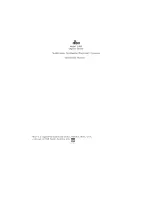
Front Panel
LEVEL FADERS
1-16
RATIO FADERS
1-16
Use these faders to set the level for each partial.
Use these faders to set the ratio (pitch) for each partial.
Keep in mind that if you modulate partial 1 ratio via CV
the pitch of all other partials will be effected since they
are ratios in relation to the first partial.
FREQUENCY MODULATION
16 operators in 5 groups
Levels and ratios?
A brief introduction
The partials in SineSynth can modulate each other by
activating the FREQUENCY MODUALTION switches.
The routing shown on the panel explains how they
interact:
Partials 1, 5, 8, 11 and 14 are carriers whilst the others
are modulators. The first group contains 4 Operators
while the other 4 groups contains 3 each.
The carriers will be modulated be the next partial, which
in turn is modulated by the next after that. The amount
of modulation is set with the Level fader of each Partial.
SineSynth is an additive synthesizer with Frequncy
Modulation capabilities that is based around sinewaves.
Any sound can be generated by combining sinewaves
of different amplitude and frequency - you can say that
sinewaves are the building blocks of any sound!
For example a sawtooth wave is constructed of a series
of frequencies illustrated roughly here:
The peaks in the spectrum analyzer represents the
frequencies present in the sawtooth waveform. Each
peak is on it’s own a pure sinewave. So by combining
several sinewaves of different frequency and amplitude
it is possible to recreate other waveforms, even a
square wave! Well, technically it would require an near
infinite number of sinewaves to get perfectly sharp
edges, but one can come pretty close with as little as
16 sinewaves. And, when adding a waveshaper to the
signal it can get sharp edges quickly!
SineSynth has 16 sine oscillators and these are refered
to in this manual as a “Partials” because each one will
be a part of the waveshape that they form together.
By modulating the level and pitch of the partials you
can create a near infinite number of different sounds!
MOD sources – EGs and LFOs
Envelope Generators & Low Frequency Oscillators
EGs and LFOs are used to modulate the levels and
ratios of the partials.
EG1 & LFO1 are by default linked to levels while EG2
and LFO2 are linked to ratios. These can be unlinked
by using the MOD switch.
When EG1 and LFO1 MOD is set to “ALL” all partial
levels are modulated by both EG1 and LFO1. When set
to IND. the partial levels are modulated by the source
set below each partials level fader. Notice that the
source selector is not operational when EG1 and LFO1
MOD is set to ALL.
When EG2 and LFO2 MOD is set to ALL all partial
ratios are modulated by both EG2 and LFO2. When set
to IND. the partial ratios are modulated by the source
set below each partials ratio fader. Notice that the
source selector is not operational when EG2 and LFO2
MOD is set to ALL.
When MOD is set to IND. the first partial (1) level
and ratio is fixed at the fader position and connot be
modulated by EGs or LFOs. This is handy since the first
partial will be a stable reference point for balancing and
tuning the other partials to.
The active modulation sources are indicated by the four
LEDs below partial 1 level and ratio.
The LFOs can be set to RETRIG with each note and
SYNC to the song tempo with the two corresponding
switches.
LFO1 has a sharp random wave shape whilst LFO2
has a softer drifting random wave shape.
EG2 and LFO2 has a deeper modulation effect, about
10x as strong as EG1 and LFO1.
NOISE
Analog & Digital
SHAPER
OUTPUT
Level
Add white NOISE to the oscillator signal. When set to
digital the signal also goes through a bit reduction filter
for lo-fi fidelity. The noise level is controlled by EG1.
Use the TYPE switch set what type of shaping to apply.
“I” is Soft Ring Modulation, “II” is Hard Ring Modulation
and “III” is waveshaping by applying a Tahn shape drive
to the signal.
Set the over all volume with the LEVEL knob. The
output level is shaped by Envelope Generator 1.
There is a hard clipping limiter on the output, to avoid
extreme audio peaks.
EFFECTS
Echo & Reverb
The ECHO TIME can be set to SYNC to the song
tempo using the switch. FEEDBACK will controll how
many repetitions are made and MIX will set the balance
of echo and dry signal.
Reverb DECAY controlls the length of the
reverberation. For imitating large spaces use longer
decay time. The TONE controll will dull or brighten the
decay signal. The MIX will set the balance of reverb
and dry signal.
Sawtooth wave in an oscilloscope
Sawtooth wave in spectrum analyzer
OUT
OUT
OUT
OUT
OUT
















